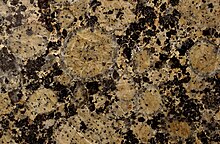Rapakivi granite

Rapakivi granite is a
Rapakivi was first described by
Occurrence

Rapakivi is a fairly uncommon type of granite, but has been described from localities in North and South America (Illescas Batholith, Uruguay,[5] Rondônia, Brazil[6]) parts of the Baltic Shield, southern Greenland, southern Africa, India and China. Most of these examples are found within Proterozoic metamorphic belts, although both Archaean and Phanerozoic examples are known.
Formation
Rapakivi granites have formation ages from Archean to recent and are usually attributed to anorogenic tectonic settings. They have formed in shallow (a few km deep) sills of up to 10 km thickness.[citation needed]
Rapakivi granites are often found associated with intrusions of anorthosite, norite, charnockite and mangerite. It has been suggested that the entire suite results from the fractional crystallization of a single parental magma.[7][note 1]
Geochemistry
Rapakivi is enriched in K, Rb, Pb, Nb, Ta, Zr, Hf, Zn, Ga, Sn, Th, U, F and
Rapakivi is high in fluoride, ranging 0.04–1.53%, compared to other similar rocks at around 0.35%. Consequently, groundwater in rapakivi zones is high in fluoride (1–2 mg/L), making the water naturally fluoridated. Some water companies actually have to remove fluoride from the water.[9][10]
The uranium content of rapakivi is fairly high, up to 24 ppm. Thus, in rapakivi zones, the hazard from radon, a decay product of uranium, is elevated. Some indoor spaces surpass the 400 Bq/m3 safety limit.[11][12]

Petrography

Vorma (1976) states that rapakivi granites can be defined as:[13]
- Orthoclase crystals have rounded shape
- Most (but not all) orthoclase crystals have plagioclase rims (wiborgite or viborgite type, named after the city of Vyborg)[14]: 157
- Orthoclase and quartz have crystallized in two phases, early quartz is in tear-drop shaped crystals (pyterlite type, named after the location of Pyterlahti).[14]: 134 [15]
A more recent definition by Haapala & Rämö states:[16]
Rapakivi granites are type-A granites, where at least in larger associated
batholiteshave granites with rapakivi structures.
Use as a building material
Rapakivi is the material used in
Notes
- graniticized" Jotnian sediments, an idea which is now discredited.[8]
References
- ^ "Definition of RAPAKIVI".
- ^ Tietoaineistot – maaperäkartan käyttöopas – rapautuminen – GTK
- ^ "Ueber die finnländischen Rapakiwigesteine
- ^ "3000 miljoonaa vuotta, Suomen Kallioperä"
Finnish geological society, 1998, chapter 9, ISBN 952-90-9260-1. Language: Finnish.
- .
- .
- ^ Zhang, S-H., Liu, S-W., Zhao, Y., Yang, J-H. Song, B. and Liu, X-M. The 1.75–1.68 Ga anorthosite-mangerite-alkali granitoid-rapakivi granite suite from the northern North China Craton: Magmatism related to a Paleoproterozoic orogen. Precambrian Research, 155, 287–312.
- .
- ^ a b Rämö, T., Haapala, I. ja Laitakari, I. 1998. Rapakivigraniitit – peruskallio repeää ja sen juuret sulavat. In: Lehtinen, M., Nurmi, RA., Rämö, O.T. (Toim.), Suomen kallioperä – 3000 vuosimiljoonaa. Suomen geologinen seura. Gummerus kirjapaino, Jyväskylä. 257–283.
- .
- ^ Valmari, T., Arvela, H., ja Reisbacka, H. 2012. Radon in Finnish apartment buildings. Radiation Protection Dosimetry, 152, 146–149.
- ^ Weltner, A., Mäkeläinen, I., ja Arvela, H. 2002. Radon mapping strategy in Finland. In: International Congress Series 1225, 63–69.
- ^ Vorma A., 1976. On the petrochemistry of rapakivi granites with special reference to the Laitila massif, southwestern Finland. Geological Survey of Finland, Bulletin 285, 98 pages.
- ^ ISBN 978-0-521-66215-4.
- ^ Walter Wahl: Die Gesteine des Wiborger Rapakiwigebietes. Fennia, Band 45/20, Helsingfors (Tilgmann) 1925, p. 24
- S2CID 129835203.
- ^ Eckerö church, Retrieved 2012-10-19.
- .
- ^ North Carolina Museum of Natural Sciences blog, Retrieved 2012-10-19.
- ^ "Baltic Brown". Finnish Natural Stones. KIVI, Finnish Natural Stone Industry Association. Retrieved 12 April 2024.
